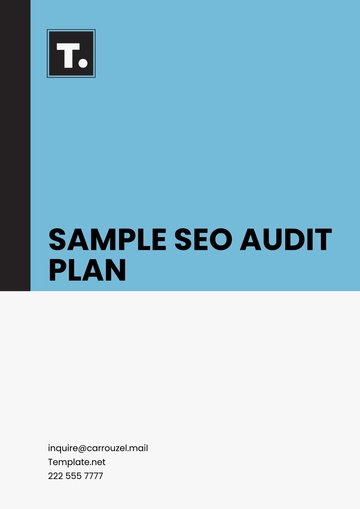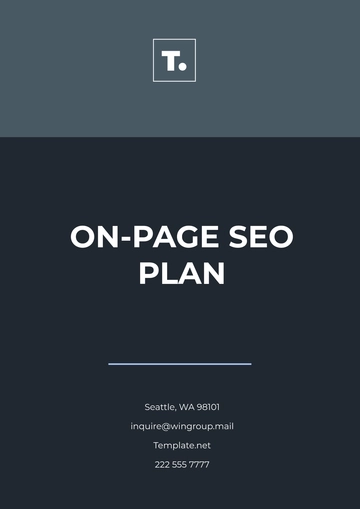Free Long-Term SEO Strategy Plan Format

Prepared by: [Your Name]
Date: [Date]
I. Introduction
Business Overview: Brief description of the business, its products or services, and target audience.
SEO Goals: Define clear, measurable objectives for the SEO efforts, such as increasing organic traffic, improving keyword rankings, or enhancing user engagement.
II. SEO Audit
Current Website Performance: Analyze current traffic levels, search rankings, and overall SEO health.
On-Page SEO: Evaluate elements like meta tags, keyword usage, content structure, and internal linking.
Off-Page SEO: Assess backlink profile, domain authority, and external factors affecting rankings.
Technical SEO: Examine website architecture, site speed, mobile-friendliness, and URL structure.
III. Keyword Research
Target Keyword Identification: Choose primary and secondary keywords based on search volume, competition, and relevance to the business.
Keyword Mapping: Assign specific keywords to relevant pages or content across the website.
Competitor Analysis: Review competitors’ keyword strategies to identify gaps and opportunities.
IV. Content Strategy
Content Creation: Plan for creating high-quality, relevant, and optimized content (blogs, videos, infographics, etc.).
Content Optimization: Ensure existing content is optimized for target keywords and user intent.
Content Distribution: Identify platforms and methods for distributing content, such as social media, email newsletters, or guest posting.
V. Link Building Strategy
Backlink Acquisition: Plan for obtaining high-quality, authoritative backlinks from reputable sites.
Guest Blogging: Target opportunities to contribute content on other blogs in the same niche.
Broken Link Building: Identify broken links on relevant sites and offer replacement links to your content.
VI. Technical SEO
Website Architecture: Improve site navigation, structure, and internal linking to enhance crawlability.
Mobile Optimization: Ensure the website is responsive and user-friendly on mobile devices.
Site Speed: Identify areas for improvement in loading times, such as optimizing images and using content delivery networks (CDNs).
VII. Tracking and Metrics
Key Performance Indicators (KPIs): Set metrics like organic traffic growth, conversion rates, keyword rankings, and bounce rates to track progress.
Tools and Software: List tools used for tracking SEO performance, such as Google Analytics, Google Search Console, and SEMrush.
Regular Reporting: Establish a schedule for SEO performance reports and adjustments.
VIII. Timeline
Phase 1: Initial audit, keyword research, and content optimization (Months 1-3).
Phase 2: Implementation of on-page SEO improvements, link building, and content creation (Months 4-6).
Phase 3: Ongoing optimization, expansion of content strategy, and further link acquisition (Months 7+).
IX. Budget
SEO Tools and Software: Allocate funds for tools like SEMrush, Ahrefs, or Moz.
Content Creation: Budget for hiring writers, designers, or video producers.
Outreach and Link Building: Estimate costs for outreach campaigns, guest blogging, and influencer partnerships.
- 100% Customizable, free editor
- Access 1 Million+ Templates, photo’s & graphics
- Download or share as a template
- Click and replace photos, graphics, text, backgrounds
- Resize, crop, AI write & more
- Access advanced editor
The Long-Term SEO Strategy Plan Format Template from Template.net is your go-to resource for crafting a sustainable SEO approach. This editable and customizable template provides a structured format for outlining long-term goals and actionable steps. Easily editable in our Ai Editor Tool, it enables you to tailor strategies that drive consistent growth and improve search rankings over time.
You may also like
- Finance Plan
- Construction Plan
- Sales Plan
- Development Plan
- Career Plan
- Budget Plan
- HR Plan
- Education Plan
- Transition Plan
- Work Plan
- Training Plan
- Communication Plan
- Operation Plan
- Health And Safety Plan
- Strategy Plan
- Professional Development Plan
- Advertising Plan
- Risk Management Plan
- Restaurant Plan
- School Plan
- Nursing Home Patient Care Plan
- Nursing Care Plan
- Plan Event
- Startup Plan
- Social Media Plan
- Staffing Plan
- Annual Plan
- Content Plan
- Payment Plan
- Implementation Plan
- Hotel Plan
- Workout Plan
- Accounting Plan
- Campaign Plan
- Essay Plan
- 30 60 90 Day Plan
- Research Plan
- Recruitment Plan
- 90 Day Plan
- Quarterly Plan
- Emergency Plan
- 5 Year Plan
- Gym Plan
- Personal Plan
- IT and Software Plan
- Treatment Plan
- Real Estate Plan
- Law Firm Plan
- Healthcare Plan
- Improvement Plan
- Media Plan
- 5 Year Business Plan
- Learning Plan
- Marketing Campaign Plan
- Travel Agency Plan
- Cleaning Services Plan
- Interior Design Plan
- Performance Plan
- PR Plan
- Birth Plan
- Life Plan
- SEO Plan
- Disaster Recovery Plan
- Continuity Plan
- Launch Plan
- Legal Plan
- Behavior Plan
- Performance Improvement Plan
- Salon Plan
- Security Plan
- Security Management Plan
- Employee Development Plan
- Quality Plan
- Service Improvement Plan
- Growth Plan
- Incident Response Plan
- Basketball Plan
- Emergency Action Plan
- Product Launch Plan
- Spa Plan
- Employee Training Plan
- Data Analysis Plan
- Employee Action Plan
- Territory Plan
- Audit Plan
- Classroom Plan
- Activity Plan
- Parenting Plan
- Care Plan
- Project Execution Plan
- Exercise Plan
- Internship Plan
- Software Development Plan
- Continuous Improvement Plan
- Leave Plan
- 90 Day Sales Plan
- Advertising Agency Plan
- Employee Transition Plan
- Smart Action Plan
- Workplace Safety Plan
- Behavior Change Plan
- Contingency Plan
- Continuity of Operations Plan
- Health Plan
- Quality Control Plan
- Self Plan
- Sports Development Plan
- Change Management Plan
- Ecommerce Plan
- Personal Financial Plan
- Process Improvement Plan
- 30-60-90 Day Sales Plan
- Crisis Management Plan
- Engagement Plan
- Execution Plan
- Pandemic Plan
- Quality Assurance Plan
- Service Continuity Plan
- Agile Project Plan
- Fundraising Plan
- Job Transition Plan
- Asset Maintenance Plan
- Maintenance Plan
- Software Test Plan
- Staff Training and Development Plan
- 3 Year Plan
- Brand Activation Plan
- Release Plan
- Resource Plan
- Risk Mitigation Plan
- Teacher Plan
- 30 60 90 Day Plan for New Manager
- Food Safety Plan
- Food Truck Plan
- Hiring Plan
- Quality Management Plan
- Wellness Plan
- Behavior Intervention Plan
- Bonus Plan
- Investment Plan
- Maternity Leave Plan
- Pandemic Response Plan
- Succession Planning
- Coaching Plan
- Configuration Management Plan
- Remote Work Plan
- Self Care Plan
- Teaching Plan
- 100-Day Plan
- HACCP Plan
- Student Plan
- Sustainability Plan
- 30 60 90 Day Plan for Interview
- Access Plan
- Site Specific Safety Plan




























